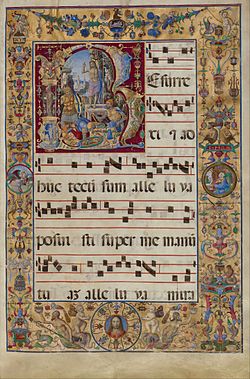Resurrexi
| Resurrexi | |
|---|---|

|
|
| General | |
| Use: | Introitus |
| Liturgical calendar : | Easter Sunday / Dominica Resurrectionis |
| Text origin: | Psalm 139 |
| Mode : | Fourth tone |
| Choral book : | Graduale Romanum , p. 202, Graduale Triplex , p. 196 |
Resurrexi ( Latin "I am resurrected") is the incipit of the Gregorian Introit on Easter Sunday .
text
The text of the introit is divided into three by three units; it reads:
- Resurrexi - et adhuc tecum sum, - alleluia.
- Posuisti super me - manum tuam, - alleluia.
- Mirabilis facta est - scientia tua, - alleluia, alleluia.
Translation:
- I am risen and I am always with you. Alleluia.
- You put your hand on me Alleluia.
- How wonderful this knowledge is for me.
The text of both the antiphon and the verse are inspired by Psalm 138/139 . The use of the textual material of the Psalm is quite free: only verses 8, 5 and 6 are used. The translation is also very free and is entirely at the service of interpreting the resurrection . While in the psalm translation of the Vulgate the verse with ex surrexi - "I'm on ge stood" - begins reinterprets the re surrexi the Introit '- "I'm on it were" - Psalm in view of the Easter event. The psalm words of King David are thus explained as words of Jesus to God the Father .
The text of the verse is:
Domine, probasti me,
et cognovisti me:
tu cognovisti sessionem meam,
et resurrectionem meam.
Translation:
Lord you have explored me
and you know me.
You know my sitting
and my getting up.
melody
The melody of the introit is on the fourth note . At first glance, it is surprising that on the Church's highest holiday, the Introit is not in a triumphant mode, such as the Doric of the Easter sequence Victimae paschali laudes . The fourth mode, on the other hand, is described as lovely: Quartus dicitur fieri blandus. The melody, too, is surprisingly unadorned, peaceful and almost monotonous. Their length does not even exceed a fifth.
Interpreters explain this apparent contradiction as a wonderful harmony between text and melody: The lyrical self of the text is not - as in the sequence, for example - the people of God in joy at the resurrection, but the risen Christ himself. Exuberant joy, however, would hardly be an exuberant joy appropriate expression: non in commotione Dominus .
Recordings
- Chants De L'Eglise De Rome . Période Byzantine. 1986, Harmonia Mundi , HMC 901218, CD ( Marcel Pérès , Ensemble Organum ).
Gregorian chant
- Fete de Pâques . 1976, Art & Musique AM / CD / 107/37606, CD (choir of the monks of the Abbey of Notre-Dame de Fontgombault , conducted by Père Duchène).
- Louis Vierne: Mass Solennelle, Op. 16. 2010, JAV Recordings # JAV179, CD ( Daniel Roth , Eric Lebrun , Choeur Gregorien De Paris , Choeur d'oratorio de Paris ).
Further settings
- Resurrexi (William Byrd)
- Resurrexi (Robert Hugill)
- Resurrexi (Giovanni Girolamo Kapsperger)
- Resurrexi (Giovanni Bonaventura Matucci)
- Resurrexi (Antonio Nola)
literature
- Dom Lucien David : L'Introït de Pâques . In: Revue de Chant grégorien . No. 5 , 1912, pp. 145-152 (French).
further reading
- Joseph Gajard: Les plus belles mélodies grégoriennes . Edition de Solesmes, Solesmes 1985, ISBN 2-85274-196-2 , pp. 139-145 (French, 270 pages).
- René-Jean Hesbert (ed.): Antiphonale missarum sextuplex: D'après le Graduel de Monza et les Antiphonaires de Rheinau, du Montblandin, de Compiègne, de Corbie et de Senlis . Reprint of the 1st edition, 1935. Herder, Rome 1985, No. 80 (256 pages).
